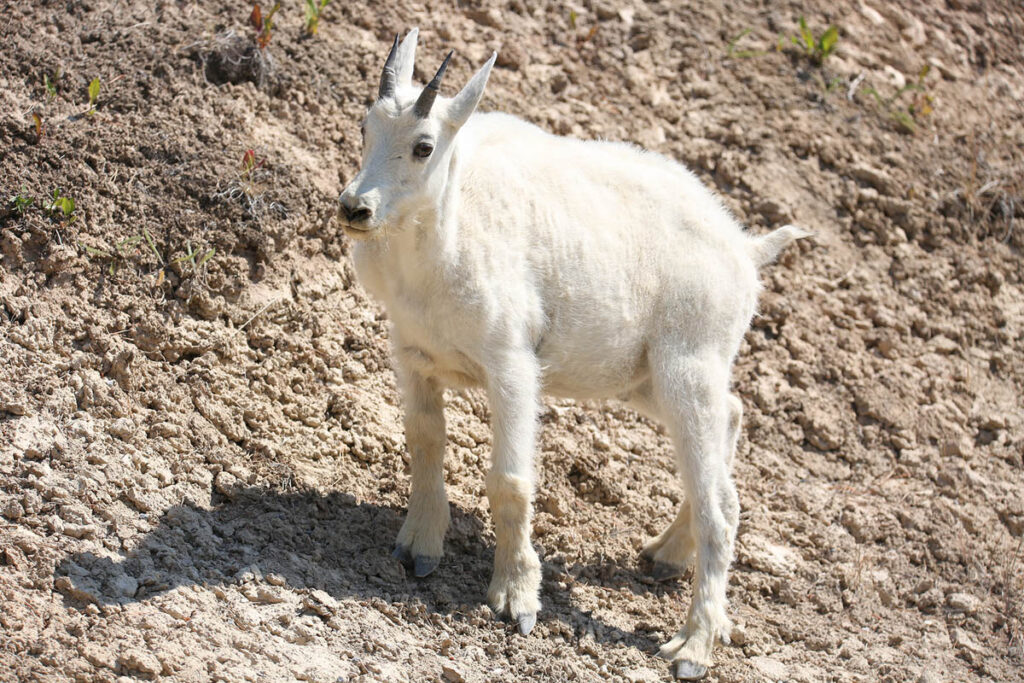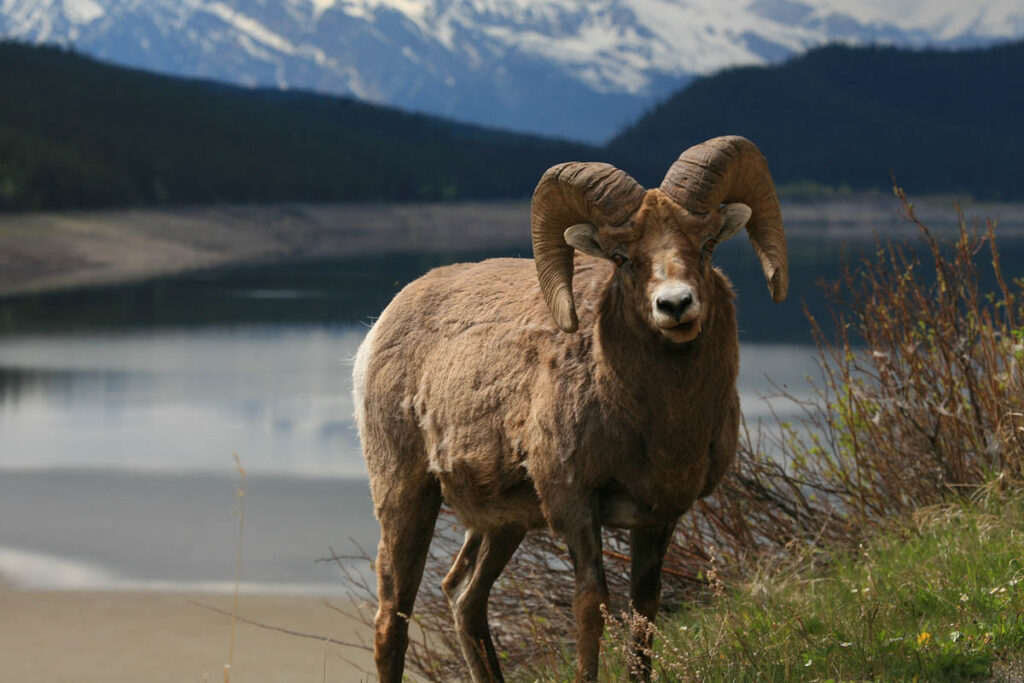Jasper National Park Wildlife Viewing
Jasper National Park wildlife viewing is a major attraction as wildlife is abundant in Jasper National Park and can be viewed year-round.
One of the best viewing times is winter, when many larger mammals move to lower elevations where food is accessible. February and March are particularly good for looking for animal tracks in the snow. By June, most of the snow cover at lower elevations has melted, the crowds haven’t arrived, and animals can be seen feeding along the valley floor. In fall, tourists move to warmer climates, the rutting season begins, bears go into hibernation, and a herd of elk moves into downtown Jasper for the winter.
For descriptions of all wildlife species present in Jasper National Park, visit our Jasper National Park Nature Guide.

Goats and Glaciers Viewpoint, on the Icefields Parkway, is one of the best places in the Canadian Rockies to see mountain goats.
Bears
Bears create the most attention on park roads and can be seen between April and October. Numbering around 100 within Jasper National Park, black bears are widespread and occasionally wander into campgrounds looking for food. They are most commonly seen along the Icefields Parkway and Maligne Lake Road in spring, when they first come out of hibernation. Although not as common as black bears, grizzly bears are widespread throughout Jasper National Park and are occasionally seen crossing highways or grazing at higher elevations early in summer.
Elk, Deer, Mountain Goats, and Sheep
Few people leave Jasper without having seen elk, of which a few hundred live in and around the town of Jasper. The large-eared mule deer is commonly seen around the edge of the town or grazing along the north end of the Icefields Parkway. White-tailed deer can be seen throughout Jasper National Park. A small herd of woodland caribou roams throughout Jasper National Park; they are seen during late spring in the Opal Hills or along a signposted stretch of the Icefields Parkway. Moose, although numbering fewer than 100 in all of Jasper, can occasionally be seen feeding on aquatic plants along the major drainage systems.
In summer, mountain goats browse in alpine meadows. A good place for goat watching is Goats and Glacier Lookout on the Icefields Parkway. Unlike most of Jasper National Park’s large mammals, these sure-footed creatures don’t migrate to lower elevations in winter but stay sheltered on rocky crags where wind and sun keep the vegetation snow free.
Often confused with the goat is the darker bighorn sheep. The horns on the males of this species are thick and often curl 360 degrees. Bighorns are common in the east of Jasper National Park at Disaster Point and will often approach cars. An estimated 2,500 bighorn reside in Jasper National Park.

A bighorn sheep photographed at Medicine Lake.
Small Mammals
Several species of small mammals thrive around campgrounds, thanks to an abundance of humans who are careless with their food. Columbian ground squirrels are bold and will demand scraps of your lunch. Golden-mantled ground squirrels and red squirrels are also common. The least chipmunk (often confused with the golden-mantled ground squirrel thanks to similar stripes) can also be seen in campgrounds; they’ll often scamper across your hiking trail, then sit boldly on a rock waiting for you to pass.
Beavers are common between the town of Jasper and Jasper National Park’s east gate. Dawn and dusk are the best times to watch these intriguing creatures at work. Wabasso Lake, a 2.6-kilometre (1.6-mile) hike from the Icefields Parkway, was created by beavers; their impressive dam has completely blocked the flow of Wabasso Creek. Also common in Jasper National Park’s wetlands are mink and muskrat; search out these creatures around the lakes on the benchland north of the town of Jasper.
The pine marten is common but shy; look for them in subalpine forests. The short-tailed weasel—a relative of the marten—is also common, while the long-tailed weasel is rare. At higher elevations look for pikas in piles of fallen rock. Hoary marmots live near the upper limits of vegetation growth, where their shrill warning whistles carry across the open meadows; The Whistlers area, accessed by tramway, supports a healthy population of these noisy creatures.
Birds
The extensive tree cover in the lower valleys hides many species of birds, making them seem less abundant than they are; 300 species have been recorded. The two you’re most likely to see are the gray jay and Clark’s nutcracker, which regularly joins picnickers for lunch at day use areas throughout Jasper National Park. Also common are black-and-white magpies, raucous ravens, and several species of ducks, which can be seen around lakes in the Athabasca River Valley. Harlequin ducks nest in Jasper National Park during early summer. A stretch of the Maligne River is closed during this season to prevent human interference.
The colony of black swifts in Maligne Canyon is one of only two in Alberta. Their poorly developed legs make it difficult for them to take off from their nests in the canyon walls—they literally fall before becoming airborne. High alpine slopes are home to white-tailed ptarmigan, a type of grouse that turns white in winter. Also at this elevation are flocks of rosy finches that live under overhanging cliffs. In subalpine forests the songs of thrushes and the tapping of woodpeckers can be heard.
At dusk, great horned owls swoop silently through the trees in montane forests, their eerie call echoing through the forest. Golden eagles and bald eagles can be seen soaring high above the forests, and around a dozen pairs of ospreys are known to nest in Jasper National Park, many along the Athabasca River between town and the east park gate.
Jasper Wildlife Photography Book
Even if you’re not interested in photography, Canadian Rockies Wildlife Photography, an eBook by renowned wildlife photographer Wayne Lynch, is a great resource for searching out local wildlife. It includes all the very best places to view wildlife in Jasper National Park.
Wildlife Safety in Jasper National Park
An abundance of wildlife is one of the biggest draws of Jasper National Park. To help preserve this precious resource, obey fishing and hunting regulations and use common sense.
DO NOT FEED THE ANIMALS. Many animals may seem tame, but feeding them endangers yourself, the animal, and other visitors, as animals become aggressive when looking for handouts (even the smallest critters, such as squirrels).
STORE FOOD SAFELY. When camping, keep food in your vehicle or out of reach of animals. Just leaving it in a cooler isn’t good enough.
KEEP YOUR DISTANCE. Although it’s tempting to get close to wildlife for a better look or a photograph, it disturbs the animal and, in many cases, can be dangerous.
DRIVE CAREFULLY. The most common cause of premature death for larger mammals is being hit by vehicles, especially along Highway 16 and the Icefields Parkway, which are not fenced.
